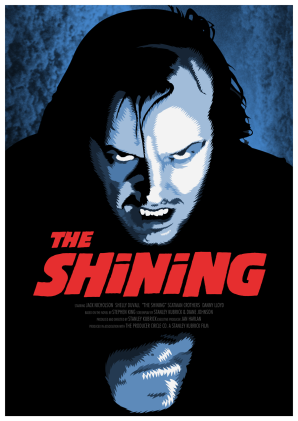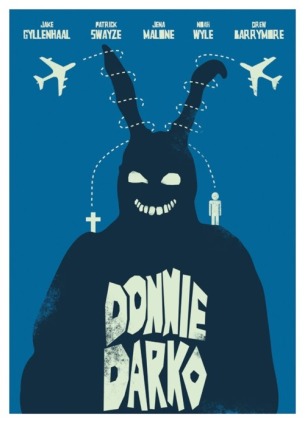Today I attended the seminar ‘The Unempty Wasps’ Nest and Kubrick’s The Shining: Rethinking Adaptation’. The focus was on adaptation and the way in which a director chooses to exclude some content from the novel they are adapting while simultaneously adding new material to it. This process was likened to the figure of the ‘Wasps’ Nest’ then in that it involves both an emptying and a refilling and it was discussed specifically in relation to how Stanley Kubrick chose to represent the interior monologue of Stephen King’s novel in the film. While the internal monologue of characters is central to the horror of King’s novel, it is not possible to show it in the medium of cinema and Kubrick had to remove it from his adaptation (emptying). However, he compensates for this by bringing something new and just as frightening to it (refilling). In order to represent interiority of characters, Kubrick instead emphasises characters’ vision and point of view (the metaphor of the wasps’ nest is furthered here in that wasps have lidless eyes and therefore perpetual vision like a camera). A typical technique of representing what characters can see in film is to show their face before focusing on what they are looking at. Kubrick’s emphasis on characters’ perspective in the film is frightening because he unsettles this technique. For example, the scene where Jack and Wendy are discussing about whether to leave the hotel cuts to a shot of Danny with his eyes wide open while their voices can be heard. Because we are used to the technique of representing characters’ perspective, we as an audience assume he can hear them and this is what is disturbing him. However, this scene cuts to a phantasmic or illusory scene of blood spilling through one of the halls in the hotel. Here, it is difficult to determine what exactly Danny is seeing and the distinction between imaginary and reality is confused. This is frightening because it makes the viewer distrust what they are seeing and loose confidence in the reliance of their eyes. Indeed, Freud says in ‘The ‘Uncanny’’ that an uncanny effect is produced when ‘the distinction between imagination and reality is effaced’. If the horror of King’s novel lies in his representation of the interiority of characters then, the horror of the film is the reverse of this in that it lies in our uncertainty as to what is going on in characters’ minds, whether they are seeing or imagining.
This blurring between the real and the imaginary is a recurring theme in horror and in contemporary horror, it is taken a step further because of the current interest in drug abuse and psychological disorders. Indeed, the boundary between reality and imagination is further confused when the protagonist engages in substance abuse or suffers from mental illness because their altered perception of reality has to be taken into account as well. In Twin Peaks: Fire Walk with Me, for example, Laura Palmer is a cocaine addict and undergoes hallucinations. She is also a victim of childhood abuse from her father Leland who is regularly possessed by a demon from another dimension called BOB. Whenever Leland hurts Laura, she sees him as the demon. It is difficult to distinguish between the real and imaginary then because we are offered two conflicting explanations of events. Because Laura is on drugs, it is strongly implied that she is hallucinating and sees BOB in place of her father. Indeed, before Leland/BOB enters her room at night, Laura is usually shown taking cocaine. At the same time, however, BOB’s existence is confirmed in that he is seen and discussed by other characters. Because of the introduction of substance abuse into the narrative then, the real and imaginary are indistinguishable.
A similar hesitation between a material and supernatural explanation of events can be found in the film Donnie Darko. The protagonist Donnie suffers from paranoid schizophrenia and it is suggested that he is on medication. Throughout the film, Donnie sees and converses with Frank, a time traveller wearing a horrific rabbit costume. Like Fire Walk with Me, it is difficult to discern whether these encounters are actually happening. Once again, we are offered conflicting explanations of events because of the protagonists’ altered perception. For instance, we can take it that Donnie is a schizophrenic and is hallucinating Frank. In the scene where Donnie is in his therapist’s office, for example, she says she cannot see him while Frank menacingly stands behind her. However, it is simultaneously suggested in the film that Frank is real. As in The Shining, the camera focuses on Donnie’s face and eyes in this scene and then cuts to Frank thereby letting us know that this is what Donnie is seeing. However, when he turns away, the scene is still intercut with shots of Frank which suggests that he is not merely a figment of Donnie’s imagination. Moreover, when Donnie meets Frank at the cinema, Frank removes his mask and he is revealed to be a young man with a bleeding eye. Then when Donnie meets his sister’s boyfriend later at a Halloween party, he is identical in appearance to Frank and wears the same rabbit costume. Also, a confrontation between the two ends in Donnie shooting Frank in the eye, thus suggesting that Frank is in fact a time traveller because he has earlier shown Donnie his bleeding eye when he met him at the cinema. Viewers are thereby uncertain as to whether the film is depicting reality or Donnie’s altered perception of it.
Therefore, horror in film, in contrast to novels, derives from the form’s inability to clearly represent the inner workings of the mind.
This is a scene from The Shining. It is the first time in the film that Danny experiences the vision of the blood:
http://www.youtube.com/watch?v=jeVfLOqtPR8
This is a scene from Donnie Darko in which Donnie’s therapist informs his parents of his friend Frank. Their discussion of mental illness further confuses the boundary between the real and the imaginary here because this scene is intercut with Donnie seeing, according to cinematic conventions that is, Frank in the mirror, and we as an audience are not sure whose perception to trust in this scene:
vimeo.com/25661555
A compilation of scenes from Donnie Darko’s Frank:
http://www.youtube.com/watch?v=DFmxDgNCGY8
An article that further explores this idea of altered perception in horror in relation to NBC’s Hannibal:
Allen, Graham. ‘The Unempty Wasps’ Nest and Kubrick’s The Shining: Rethinking Adaptation.’ University College Cork. 4 Mar. 2015. Lecture.
Donnie Darko. Dir. Richard Kelly. Newmarket Films. 2001. Film.
‘End result for Jim Cunningham: motivational speaker.’ Movies & TV. Nov 29. 2014. Accessed Mar. 2015. Web.
Freud, Sigmund. ‘The ‘Uncanny.’’ The Standard Edition of the Complete Psychological Works of Sigmund Freud. Trans. James Strachey. London: Hogarth Press and the Institute of Psycho-Analysis, 1955. 219-252. Print.
Full of Secrets: Critical Approaches to Twin Peaks. Ed. David Lavery. Detroit: Wayne State University Press, 1995. 93-108. Print.
Smith, Dan. ‘Alternative Explanations.’ Donnie Darko: The Tangent Universe. Oct 1. 2009. Accessed Mar. 2015. Web.
The Shining. Dir. Stanley Kubrick. Warner Bros, 1980. Film.
Twin Peaks: Fire Walk with Me. Dir. David Lynch. New Line Cinema, 1992. Film.


